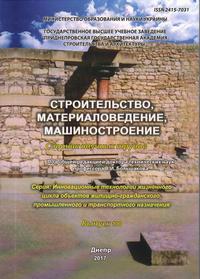Factors influencing the definition of the design features of renewable sources energy converters
Keywords:
renewable energy sources, energy-active fence, geliocollector, air layer, air-conditioning systemAbstract
Abstract. The purpose of the work is to consider the factors that affect the thermal resistance of structures in the use of elements that contribute to the transformation of solar radiation energy, the heat of the environment in the heat energy required for the consumer. The methodical approach, which is based on a constructive solution, is based on the reduction of heat losses due to the presence of energy-efficient enclosures, while increasing the processability and ease of installation. Results It is suggested to use factors that outline the features of heat transfer in the converters of solar radiation energy and lead to a certain level of microclimate in the premises. These factors include: humidity factors, the temperature difference between the temperature of the outside of the energy-active enclosure (that is, in contact with the external environment), the temperature of the base design in the room. Scientific novelty is in the fact that the proposed main factors allow to optimize the design of energy converters of renewable sources for buildings of different purposes and different conditions of placement. Examples of placement of layers in the designs of such converters in the process of decommissioning as energy-activated fences are given. The practical significance of the use of the proposed factors in the design of a converter of renewable sources contributes to the conservation of traditional energy resources through the rational use of solar energy and can be used in new construction and reconstruction of existing housing stock.References
Livchak V. I. Energosberezhenie v sistemah tsentralizovannogo teplosnabzheniya na novom etape razvitiya [Energy saving in district heating systems at a new stage of development] // Energosberezhenie. 2000. no2. P. 4–9.
Sharapov V. I., Rotov P. V. Regulirovanie nagruzki sistem teplosnabzheniya [Regulation of the load of heat supply systems]. M.: Izdatelstvo «Novosti teplosnabzheniya», 2007. 164 p.
Carbonell Daniel, Haller Michel Y., Philippen Daniel and Frank Elimar. Simulations of Combined Solar Thermal and Heat Pump Systems for Domestic Hot Water and Space Heating // Energy Procedia. 2014. Vol. 48. P. 524–534.
Redko O. F., Taraday O.M., Chernokrilyuk V.V. and Esin E.S. Kombinovani sistemi teplopostachannya z vidnovlyuvalnimi dzherelami tepla [Combined heat supply systems with heat-hung heaters] // Energosberezhenie, energetika, energoaudit. 2014. no10 (129). p.42-46.
Ganzha N.G., Himenko A.V. Teplovoe akkumulirovanie kak sposob plvyisheniya energeticheskoy effektivnosti sistem teplosnabzheniya [Thermal storage as a way to increase the energy efficiency of heat supply systems] // Energosberezhenie, energetika, energoaudit. 2012. no 3 (97). p.16-21.
Amerhanov R. A., Dolinskiy A. A. and Morozyuk T.V. Akkumulirovanie teplotyi v sistemahteplosnabzheniya selskogo hozyaystva [Accumulation of heat in the heat supply systems of agriculture] // Promyishlennaya teplotehnika. 2002. no 1. p 106–108.
Matsevityiy Yu.M., Ganzha N. G. and Himenko A. V. Otsenka energeticheskoy effektivnosti sistema elektroteploakkumulyatsionnogo otopleniya administrativnyih zdaniy [Evaluation of energy efficiency system of electric heat storage of administrative buildings] // Energosberezhenie. Energetika. Energoaudit. 2011. no 10. p. 9–16.
Nakashidze L.V., Gabrinets V.A. Osnovnyie elementyi innovatsionnoy kompleksnoy sistemyi klimatizatsii, s ispolzovaniem energii alternativnyih istochnikov [The main elements of the innovative integrated climate system, using alternative energy sources] //Stroitelstvo, materialovedenie, mashinostroenie. Vol. 68. Dn-sk: GVUZPGASA, 2013. p. 240-243.
Nakashidze L.V. Uluchshenie ekspluatatsionnyih harakteristik sooruzheniy pri ispolzovanii energii alternativnyih istochnikov [Improving the operational characteristics of buildings using alternative energy sources] //Mezhdunarodnyiy nauchnyiy zhurnal «Alternativnaya energetika i ekologiya». 2014. no 23. p. 84-89.
Ilinskiy V.M. Stroitelnaya teplofizika [Constructive Thermal Physics] M.: Vyisshaya shkola, 1974. 320 p.
Ametistov E.A., Grigorev V.A., Emtsev B.T. etc. Teplotehnicheskiy eksperiment: Spravochnik [Heat engineering experiment]. M.: Energoizdat, 1982. 512 p.
Стаття рекомендована до публікації д-ром техн. наук, проф. В.О. Габрінець (Україна); д-ром техн. наук,проф. М.М. Дронь (Україна).
Downloads
Published
Issue
Section
License
Редакція Видання категорично засуджує прояви плагіату в статтях та вживає всіх можливих заходів для його недопущення. Плагіат розглядається як форма порушення авторських прав і наукової етики.
При виявлені у статті більш ніж 25% запозиченого тексту без відповідних посилань та використання лапок, стаття кваліфікується як така, що містить плагіат. У цьому випадку стаття більше не розглядається редакцією, а автор отримує перше попередження.
Автори, в статтях яких повторно виявлено плагіат, не зможуть публікуватися в усіх журналах Видавництва ДВНЗ «Придніпровська державна академія будівництва та архітектури».
Автори, які публікуються у цьому журналі, погоджуються з наступними умовами:
- Автори залишають за собою право на авторство своєї роботи та передають журналу право першої публікації цієї роботи на умовах ліцензії Creative Commons Attribution License, котра дозволяє іншим особам вільно розповсюджувати опубліковану роботу з обов'язковим посиланням на авторів оригінальної роботи та першу публікацію роботи у цьому журналі.
- Автори мають право укладати самостійні додаткові угоди щодо неексклюзивного розповсюдження роботи у тому вигляді, в якому вона була опублікована цим журналом (наприклад, розміщувати роботу в електронному сховищі установи або публікувати у складі монографії), за умови збереження посилання на першу публікацію роботи у цьому журналі.
- Політика журналу дозволяє і заохочує розміщення авторами в мережі Інтернет (наприклад, у сховищах установ або на особистих веб-сайтах) рукопису роботи, як до подання цього рукопису до редакції, так і під час його редакційного опрацювання, оскільки це сприяє виникненню продуктивної наукової дискусії та позитивно позначається на оперативності та динаміці цитування опублікованої роботи (див. The Effect of Open Access).

